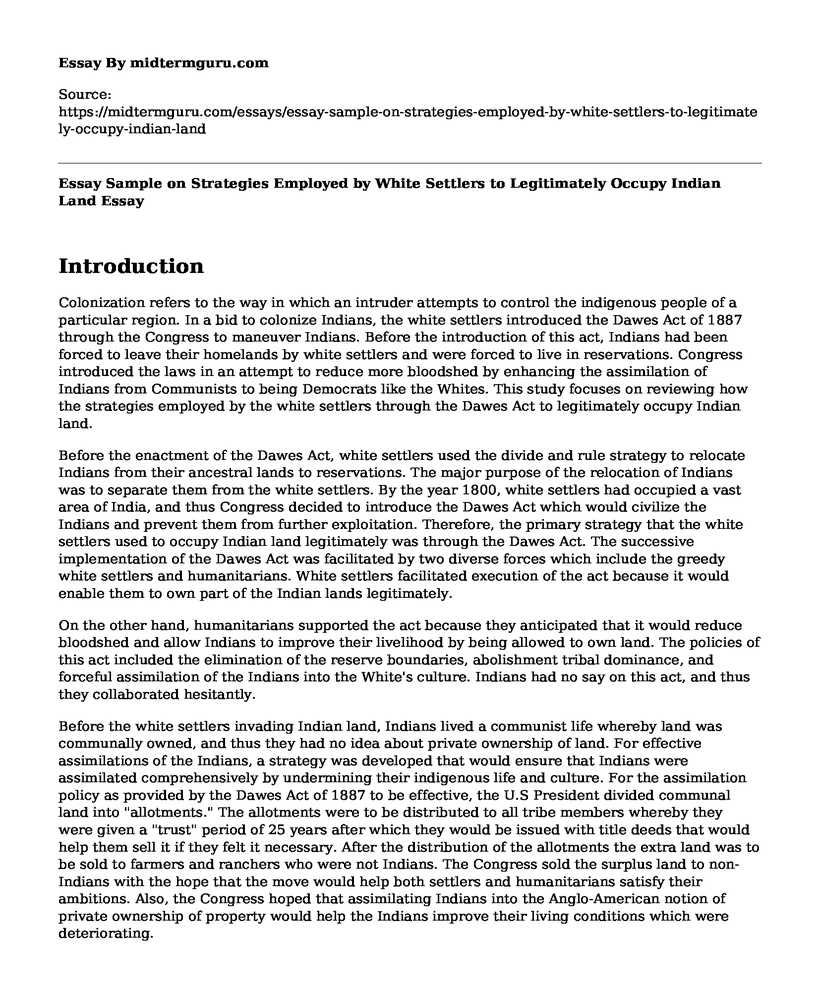Introduction
Colonization refers to the way in which an intruder attempts to control the indigenous people of a particular region. In a bid to colonize Indians, the white settlers introduced the Dawes Act of 1887 through the Congress to maneuver Indians. Before the introduction of this act, Indians had been forced to leave their homelands by white settlers and were forced to live in reservations. Congress introduced the laws in an attempt to reduce more bloodshed by enhancing the assimilation of Indians from Communists to being Democrats like the Whites. This study focuses on reviewing how the strategies employed by the white settlers through the Dawes Act to legitimately occupy Indian land.
Before the enactment of the Dawes Act, white settlers used the divide and rule strategy to relocate Indians from their ancestral lands to reservations. The major purpose of the relocation of Indians was to separate them from the white settlers. By the year 1800, white settlers had occupied a vast area of India, and thus Congress decided to introduce the Dawes Act which would civilize the Indians and prevent them from further exploitation. Therefore, the primary strategy that the white settlers used to occupy Indian land legitimately was through the Dawes Act. The successive implementation of the Dawes Act was facilitated by two diverse forces which include the greedy white settlers and humanitarians. White settlers facilitated execution of the act because it would enable them to own part of the Indian lands legitimately.
On the other hand, humanitarians supported the act because they anticipated that it would reduce bloodshed and allow Indians to improve their livelihood by being allowed to own land. The policies of this act included the elimination of the reserve boundaries, abolishment tribal dominance, and forceful assimilation of the Indians into the White's culture. Indians had no say on this act, and thus they collaborated hesitantly.
Before the white settlers invading Indian land, Indians lived a communist life whereby land was communally owned, and thus they had no idea about private ownership of land. For effective assimilations of the Indians, a strategy was developed that would ensure that Indians were assimilated comprehensively by undermining their indigenous life and culture. For the assimilation policy as provided by the Dawes Act of 1887 to be effective, the U.S President divided communal land into "allotments." The allotments were to be distributed to all tribe members whereby they were given a "trust" period of 25 years after which they would be issued with title deeds that would help them sell it if they felt it necessary. After the distribution of the allotments the extra land was to be sold to farmers and ranchers who were not Indians. The Congress sold the surplus land to non-Indians with the hope that the move would help both settlers and humanitarians satisfy their ambitions. Also, the Congress hoped that assimilating Indians into the Anglo-American notion of private ownership of property would help the Indians improve their living conditions which were deteriorating.
The Dawes Act was very effective in facilitating the greedy aims of the white settlers. The Dawes Act or General Allotment Act of 1887 acted as a treachery strategy of the white settlers to legally own Indian land. Fifty years after enactment of the Act, more than two-thirds of Indian land had been legitimately occupied by their oppressors. The outcome of the act seemed to favor the interests of non-Indians because Indians continued to suffer in poverty. Most of the land Indians were given was unsuitable for farming or it required the use of improved tools which Indians could not afford. As a result, most Indians continued to suffer in poverty while some opted to sell their allotments to non-Indians after the expiry of the "trust" period.
After the Congress realizing that the act did not favor Indians, it abolished it in the year 1934 to ensure that no more allotments happened. However, the activities of the Congress seemed to be a hoax to enable the white settlers occupy Indian land in a legitimate way while pretending that they wanted to help the Indians. By the time the General Allotment Act was abolished, it had done substantial damage on the Indians. Up-to-date Indians have no reason for celebrating the Dawes Act since it tricked them into giving away their ancestral land legitimately.
Bibliography
Arnett, Jessica Leslie. "Unsettled Rights in Territorial Alaska: Native Land, Sovereignty, and Citizenship from the Indian Reorganization Act to Termination." The Western Historical Quarterly 48, no. 3 (2017): 233-254.
Brewer II, Joseph P., Joseph G. Hiller, Shawn Burke, and Trent Teegerstrom. "A primer: Extension, Indian land tenure, and rangeland limitations." Rangelands 38, no. 1 (2016): 16-22.
Otis, Delos Sacket. The Dawes Act and the allotment of Indian lands. Vol. 123. University of Oklahoma Press, 2014.
Cite this page
Essay Sample on Strategies Employed by White Settlers to Legitimately Occupy Indian Land. (2022, Oct 31). Retrieved from https://midtermguru.com/essays/essay-sample-on-strategies-employed-by-white-settlers-to-legitimately-occupy-indian-land
If you are the original author of this essay and no longer wish to have it published on the midtermguru.com website, please click below to request its removal:
- Essay Sample on Nuclear Warfare
- Inauguration Rhetoric Analysis of Donald Trumps - Paper Example
- The Gunpowder Plot and Boston Tea Party - Paper Example
- Why We Need a State? - Paper Example
- The War of 1812 - Essay Sample
- Us Economy Strengthens: FOMC Reduces Inflation With Policy Accommodation - Essay Sample
- Teddy Roosevelt: America's Youngest and Most Impactful Leader - Essay Sample







